If you love walking around barefoot, you know how important it is to have a deck that feels good under your feet. No one wants to step onto a deck that is too hot, rough, or full of splinters. The right decking material can make all the difference in keeping your feet comfortable, cool, and safe.
This guide will help you choose the best decking material for barefoot comfort so you can enjoy your outdoor space without worrying about burning, splinters, or stubbed toes.
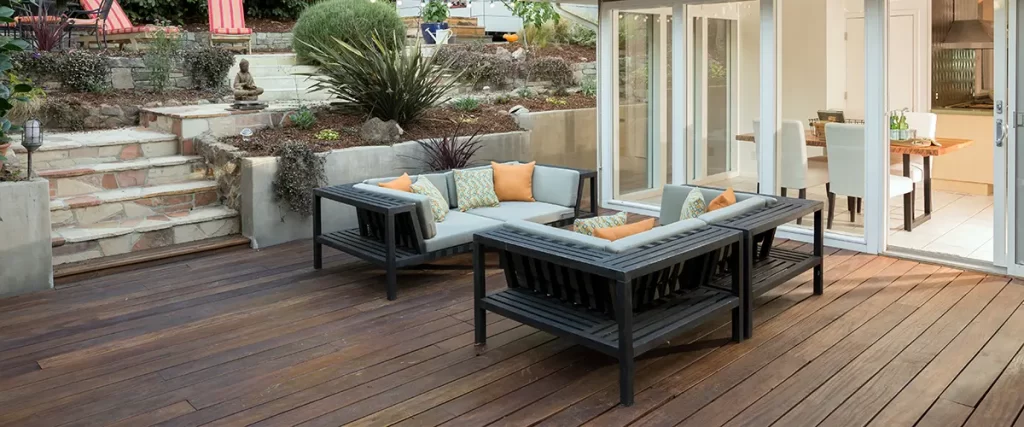
What Makes Decking Barefoot-Friendly?
Not all decking materials feel the same underfoot. Some are smooth and comfortable, while others can be rough, hot, or even dangerous to walk on without shoes. Here are the key factors that make decking barefoot-friendly:
- Smooth Surface – A deck should not have splinters or rough patches that could hurt your feet.
- Cool to the Touch – Some decking materials absorb heat and become too hot to walk on in the summer.
- Non-Slip – Wet decks can be slippery, so a little traction helps prevent falls.
- No Exposed Nails or Screws – Hidden fasteners prevent sharp edges that can hurt bare feet.
- Low Maintenance – Decking that does not require constant sanding or sealing will stay smooth and comfortable over time.
Best Decking Materials for Bare Feet
The material you choose will determine how comfortable your deck feels when walking barefoot. Here are the best options.
Composite Decking: Soft and Splinter-Free
Composite decking is a great choice for barefoot comfort because it is made from a mix of wood fibers and plastic.
- No splinters since it does not crack like natural wood.
- Stays smooth over time without rough patches.
- Uses hidden fasteners, meaning no exposed nails or screws.
- Cooler than some wood options, though darker colors can still get warm in direct sunlight.
Composite decking is ideal if you want a deck that feels soft and smooth without the risk of splinters. Choosing a lighter shade will help keep it from getting too hot.
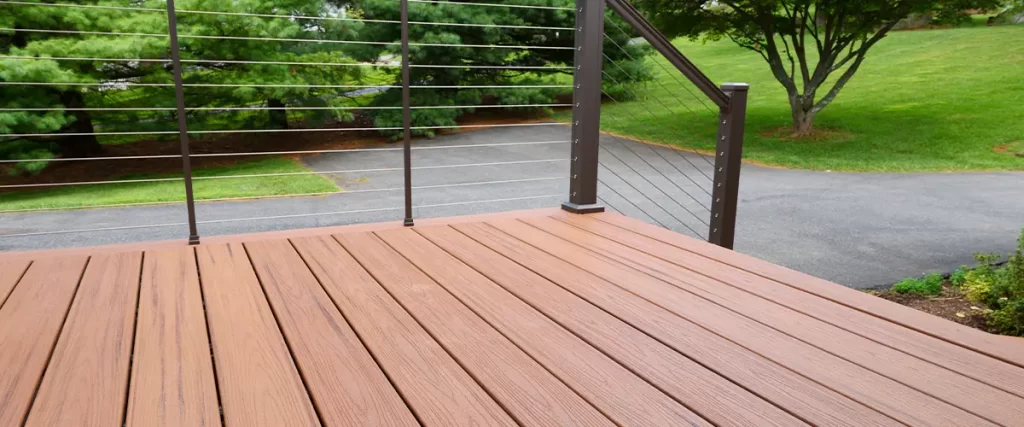
PVC Decking: Stays Cool and Comfortable
PVC decking is made entirely of plastic, making it one of the most barefoot-friendly options available.
- Does not splinter or crack.
- Stays cooler than composite, especially if it has heat-resistant technology.
- Has a smooth, comfortable surface that feels good underfoot.
If you want a deck that stays cool in the sun and is easy to maintain, PVC decking is a strong choice.
Cedar and Redwood: Soft and Natural
For those who prefer real wood, cedar and redwood are among the best choices for barefoot-friendly decking.
- Naturally softer and more comfortable underfoot than many other woods.
- Less likely to splinter compared to harder woods.
- Stays cooler than composite or PVC decking.
The downside is that cedar and redwood require regular sanding and sealing to maintain their smoothness and prevent splintering.

Pressure-Treated Wood: Not the Best for Bare Feet
Pressure-treated wood is a common decking material, but it is not the most comfortable choice for walking barefoot.
- Can splinter as it ages and dries out.
- Feels rough underfoot, even when new.
- Absorbs heat, making it hot to walk on in the summer.
If pressure-treated wood is your only option, regular sanding and sealing will help keep it smoother for bare feet.
Deck Colors and Heat Absorption
The color of your decking affects how much heat it absorbs. Some materials become very hot in direct sunlight, making them uncomfortable to walk on without shoes.
- Darker colors absorb more heat and can become too hot in warm weather.
- Lighter colors reflect sunlight and stay cooler.
For a deck that remains comfortable in the summer, choosing a light gray, tan, or beige color is a good idea.
How to Keep Your Deck Comfortable Year-Round
A barefoot-friendly deck is not just about summer comfort. Depending on your climate, you may need to consider how your deck feels during different seasons. Here are a few ways to ensure your deck is enjoyable throughout the year.
Winter Considerations
If you live in a colder climate, your deck can become slippery from ice or frost. Some materials handle cold weather better than others.
- Composite and PVC decking do not absorb as much moisture as wood, which helps prevent ice buildup.
- Wood decking can become more slippery when wet, so adding a fine-textured sealant can help improve grip.
- Non-slip mats or outdoor rugs can provide extra traction in colder months.
If you plan to use your deck year-round, choosing a material that does not crack or warp in freezing temperatures is essential.
Spring and Fall Maintenance
Spring and fall are great times to give your deck some extra care.
- Sweep away fallen leaves, as they can trap moisture and lead to mold growth.
- Check for rough spots or minor splinters and sand them down before they become worse.
- Reapply sealant to wood decks if needed to keep the surface smooth.
Regular seasonal maintenance will help ensure your deck remains comfortable for walking barefoot all year long.
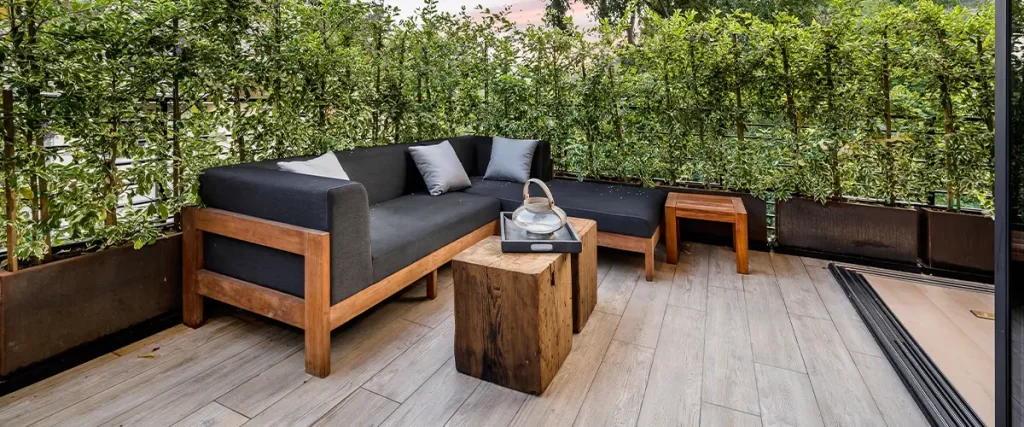
The Best Decking Board Width for Barefoot Comfort
The size of your decking boards can also affect how your deck feels underfoot.
- Wider boards have fewer gaps, which means there is less space for dirt and debris to collect. This makes cleaning easier and reduces the chance of small objects getting stuck between boards.
- Narrower boards may offer more grip, but they often require more screws or fasteners, which can be uncomfortable if not installed properly.
If you want a deck that feels smooth underfoot, choosing wider boards with hidden fasteners is a great option.
Why Ventilation Matters for Barefoot-Friendly Decks
Good airflow under your deck helps regulate temperature and prevents moisture buildup, which can lead to mold and warping.
- Raised decks allow for better air circulation, which helps keep the surface cooler.
- Ground-level decks should have proper drainage underneath to avoid trapping heat and moisture.
- Gaps between boards help prevent heat buildup and improve airflow.
If your deck tends to hold heat, improving ventilation can make a big difference in comfort.
How Furniture Affects Barefoot Comfort
Deck furniture plays a role in how comfortable your deck feels for walking barefoot. Some materials absorb heat and can become extremely hot, while others remain cooler.
- Metal furniture can become very hot in direct sunlight, making it uncomfortable to touch or move with bare feet.
- Wood furniture stays cooler but may require regular sealing to prevent splinters.
- Wicker and plastic furniture tend to be the most barefoot-friendly, as they stay cooler and have softer edges.
Choosing furniture that does not get too hot or have sharp edges will make your deck a more inviting space.
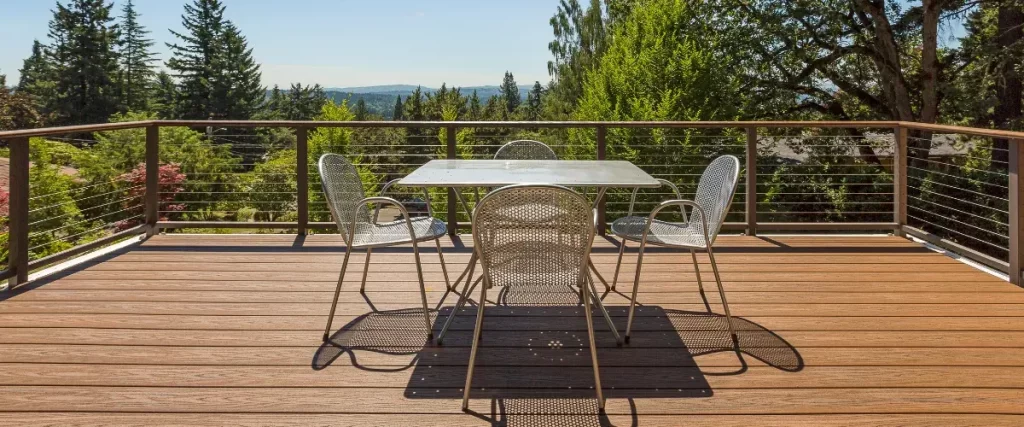
The Best Decking Layout for Sun Exposure
How you arrange your decking boards can impact how much sunlight and heat they absorb.
- Parallel boards run in one direction and can create a streamlined look. However, if the boards are positioned to follow the sun’s path, they may hold heat longer.
- Diagonal or herringbone patterns can help distribute heat more evenly across the deck surface.
- Spacing between boards affects airflow and drainage, which helps keep the deck cooler.
A well-planned deck layout can make a difference in keeping your space comfortable for barefoot walking.
Should You Add a Cooling System for Your Deck?
If you live in an area with extreme summer heat, adding a cooling system can help make your deck more enjoyable.
- Misting systems provide a fine spray of water that evaporates quickly, lowering the surface temperature.
- Shade sails can block some sunlight while still allowing airflow.
- Outdoor ceiling fans help circulate air on covered decks to keep the space cooler.
Even a simple cooling feature can help make your deck more comfortable on hot days.
Why Deck Board Spacing Matters for Bare Feet
The spacing between deck boards affects comfort, drainage, and airflow.
- Tighter gaps create a smoother surface, reducing the risk of small objects getting caught.
- Wider gaps allow for better drainage but may be uncomfortable to walk on if they are too large.
For barefoot-friendly decks, a moderate spacing of about 1/8 inch to 1/4 inch is ideal.
How to Prevent Splinters and Cracks in Wood Decking
Even the best wood decks can develop splinters over time. Here are a few ways to prevent rough surfaces.
- Sand your deck at least once a year to smooth out any rough spots.
- Apply a protective sealant to prevent cracks and moisture damage.
- Check for loose boards and tighten any that have started to lift.
Regular care will keep a wood deck safe and smooth for walking barefoot.
Surface Finishes for a Barefoot-Friendly Deck
The texture of your decking also plays a role in comfort.
- Smooth, sanded finishes feel best underfoot.
- Brushed textures provide some grip but can feel rough.
- Grooved or embossed patterns offer traction without making the surface too rough.
If choosing real wood, sanding and sealing it will keep it smooth and safe for bare feet.
Hidden Fasteners for a Safer Surface
Traditional decks use nails or screws, which can stick up over time and cause injuries. The best barefoot-friendly decks use hidden fasteners that hold the boards in place without visible screws.
This means:
- No sharp edges or metal sticking up.
- A cleaner, polished look.
- No risk of stubbing toes on raised nails.
Choosing a deck with hidden fasteners will make it much safer and more comfortable to walk on.
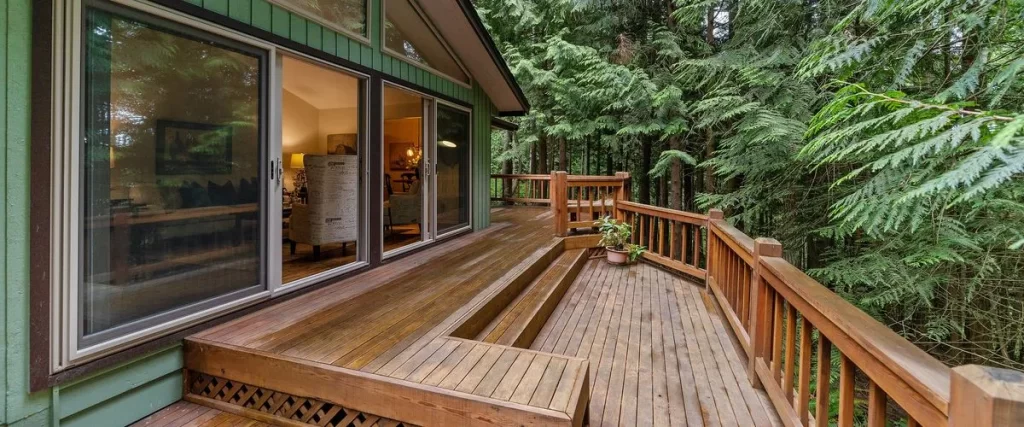
How to Keep Your Deck Barefoot-Friendly Over Time
Even the best decking material needs maintenance to stay comfortable for bare feet. Here are a few ways to keep your deck in top condition:
- Sweep regularly to remove dirt and debris that could make surfaces rough.
- Rinse the deck with water on hot days to help cool it down.
- Re-seal wood decking yearly to prevent splinters.
- Sand any rough spots before they become a problem.
- Use outdoor rugs in areas where extra comfort is needed.
Additional Features for a Barefoot-Friendly Deck
Besides choosing the right decking material, there are a few extra features that can improve comfort.
Reflective Surfaces to Reduce Heat
Adding reflective surfaces can help keep your deck cooler by bouncing sunlight away.
- Glass tabletops reflect light without absorbing heat.
- Light-colored furniture and cushions help keep the area cool.
- Mirrors or white wall panels can redirect sunlight and brighten shaded areas.
These small changes can make a big difference in how comfortable your deck feels in the summer.
Best Furniture for a Sunny, Barefoot-Friendly Deck
If your deck gets a lot of direct sunlight, choosing the right furniture is important.
- Aluminum or powder-coated metal furniture does not absorb as much heat as darker metals.
- Teak or cedar wood furniture stays naturally cool.
- Outdoor mesh seating allows airflow, keeping chairs cooler.
- UV-resistant fabrics prevent cushions from overheating and fading.
Dark plastic furniture can become extremely hot, so lighter materials are a better choice.
Water Features for a Cooling Effect
Adding a water feature can make your deck feel cooler while creating a relaxing atmosphere.
- A small fountain or water bowl can cool the air around it.
- A misting system provides a light spray to keep the area cool.
- A plunge pool or hot tub can offer a refreshing place to soak while still enjoying the deck.
Even on the hottest days, a water feature can help keep your deck enjoyable for barefoot use.
FAQ: Choosing Decking That’s Friendly to Bare Feet
What is the best decking for bare feet?
Composite, PVC, cedar, and redwood are the best choices since they are smooth, splinter-free, and stay cooler than other materials.
Does composite decking get too hot?
Darker composite decking can absorb heat, but lighter colors and heat-resistant brands stay cooler.
Which decking material stays the coolest?
PVC and light-colored wood decking tend to stay the coolest in direct sunlight.
Can you walk barefoot on pressure-treated wood?
You can, but it is not the best option. Over time, pressure-treated wood can splinter and feel rough on bare feet.
How can I make my deck more comfortable for bare feet?
Choose smooth, light-colored decking with hidden fasteners and sand down any rough spots over time.

Upgrade to a Barefoot-Friendly Deck with Riverview Decks
Walking barefoot on your deck should be a pleasant experience, not something you avoid. Whether you choose composite, PVC, or natural wood, the right decking can make all the difference in comfort and safety.
At Riverview Decks, we specialize in building decks that are smooth, cool, and safe for bare feet. If you want a deck that looks great and feels even better, we are here to help.
Contact us today at (865) 801-4545 and let’s build the perfect barefoot-friendly deck for your home in Knoxville, TN.

